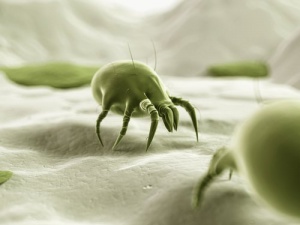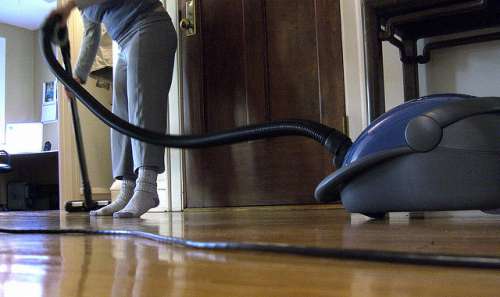How to Make a Spray for Dust Mites

Dust allergies are caused by tiny organisms known as dust mites, which cause symptoms like a stuffy nose, frequent sneezing, runny nose, coughing, itchy nose and eyes, and in the most severe cases, asthma attacks.
Dust mites belong to the diverse group of arachnids. This means they’re distantly related to spiders and scorpions. They’re found in virtually every corner of the average home, and you’re probably surrounded by them at this very minute.
However, the truth is that you’re constantly exposed to a huge world of microorganisms, of which mites are simply some of the countless beings that make it up. This means they’re not necessarily harmful. In fact, most mites are harmless and aren’t visible to the naked eye.
The species of mite that invades your home and causes allergies and respiratory problems are dust mites, or house mites. To fight these organisms and the uncomfortable symptoms they cause, it’s first important toyou need to learn a bit more about them.
You might like:
Where do you find dust mites?
Dust mites are tiny invisible organisms that are about 0.3 mm in size. They feed on the dead cells that our skin sheds. Then, the small fecal particles they produce are responsible for dust allergies. Each mite can produce about 20 of these particles a day. During their lifetime of about 10 weeks, that’s 2,000 allergy-causing particles alone. On your average mattress, there might be many thousands, or even millions, of mites.
The male mite lives for about 10 days, but the female survives for up to 70 days and can lay 60 to 100 eggs during its lifetime. At this rate, the number of mites in your home can grow exponentially.
Mites avoid light, which is why they often hide within the fibers of fabrics and materials like upholstery, mattresses, carpet, and toys. In addition, mites multiply best in areas that have high temperatures and humidity, such as attics and basements.
Dust Allergies and Their Consequences for Your Health
It’s estimated that dust mites are responsible for 50% of allergic symptoms. Inhaling them is responsible for respiratory diseases like rhinitis, a disorder that affects the nasal mucosa and causes sneezing, itching, obstructions, nasal secretions, and sometimes even lack of smell. They’re also known to trigger asthma attacks.
Mites can also cause allergic conjunctivitis, an inflammation of the eye that produces itching, redness, tear production, and the sensation of having something in your eye.
Likewise, prolonged contact with skin can generate irritation, known as atopic dermatitis, and results in itchy, inflamed patches.
Lasting Home Remedies

Fortunately, there’s no need to call a professional for mite control. You can do it all by yourself!
How to Make a Homemade Spray for Dust Mites
First and foremost, you can make a homemade insecticide to help eliminate these organisms from your fabrics and corners of the rooms. You can also buy one in stores.
To make it yourself, here’s what you need:
- A spray bottle
- ½ cup rubbing alcohol
- ½ cup distilled water
- 30 drops of essential oil (lemon, eucalyptus, lavender, cypress, cinnamon, etc)
Mix all the ingredients in your spray bottle and you’re ready to get rid of mites. Spray this mixture on your bedding, your pillows, blankets, curtains, and anywhere else dust accumulates.
However, it’s not a good idea to use this spray for dust mites if you have children under three years old or if you’re pregnant. If you do, be sure to let the mixture evaporate before using any of the items you sprayed.
The first time you apply this spray you’ll significantly reduce the mite population for about two months. To keep the area free from these organisms, however, you need to periodically reapply the spray for dust mites every two or three months.
Essential oils
Another solution is to spray your rooms every day with essential oils like lavender, mint, peppermint, or pine, to ensure you have fresher air. In addition, the smell is very pleasant.
A mix of anise, clove, fennel, thyme, and lavender sprayed on bedding and carpet also helps reduce the mite population in your bedroom. It gives your room a nice smell and makes the room feel cleaner and fresher.
However, remember that essential oils contain powerful compounds that can be irritating to some people. Apply them sparingly and make sure no one in your household is allergic to them.
Read:
Prevent Mites from Appearing
It’s essential to keep your house clean and prevent the appearance of new mites. That’s why you need to make some changes at home and create conditions that aren’t favorable for their reproduction and survival.
Here are some tips:
- Keep the humidity below 50%. Using a dehumidifier in your bedroom can reduce your chances of developing a dust allergy. In addition to this, you can by a hygrometer to measure the humidity levels in your home.
- Keep your rooms ventilated. Open the windows and turn on a fan to prevent dust particles and mites from accumulating. Try to air out your house for 15 minutes a day.
- Try to let sunlight get in all your rooms. A well-lit room isn’t an ideal space for mites to develop.
- Wash your sheets and curtains in hot water. That helps eliminate any mites living in them.
- Keeping your mattress clean is key, because it’s where you spend most of your time when you’re in contact with mites, and they’re probably there in large numbers. Make sure to spend some time cleaning your mattress and apply the spray liberally to remove all dust particles. Do this on a regular basis to prevent them from accumulating on your mattress again.
- In the summer or winter, you should take all your fabric and furniture outside and let it sit in the sun, because mites can’t survive in hot temperatures. On the other hand, they can’t tolerate wintertime lows either.
- You can always remove your carpet and other materials that shelter mites. Carpet is a favorite spot for mites to thrive. This is especially true if the carpet is on top of cement, because it easily retains moisture and provides an ideal environment for mites. If possible, replace your carpet with tile, wood, or another hard surface. Changing your furniture to something that you can remove and wash is also a good way to prevent mites from accumulating.
Removing mites from your home is an easy task, but you have to be consistent for it to be effective.Make sure to clean the most important areas on a regular basis: this includes your mattress, sheets, and carpets especially, because these are where the highest concentrations exist.
It’s also important to clean in the spring and autumn, because those are the seasons during which mites thrive.
All cited sources were thoroughly reviewed by our team to ensure their quality, reliability, currency, and validity. The bibliography of this article was considered reliable and of academic or scientific accuracy.
- Aggarwal P, Senthilkumaran S. Dust Mite Allergy. In: StatPearls [Internet]. Treasure Island (FL): StatPearls Publishing; 2022 Jan.
- Álvarez Castelló Mirta, García Gómez Iris M., Castro Almarales Raúl, Ronquillo Díaz Mercedes. Rinitis alérgica y rinosinusitis: Una revisión necesaria. Rev Cubana Med Gen Integr. 2004; 20(1), 0-0.
- CARRASCO, E., GUZMÁN, C., RODRÍGUEZ, C., SEPÚLVEDA, R., VICHERAT, L., & VILLANUEVA CH, F. A. N. O. R. Guías para el diagnóstico y manejo del asma: Recomendaciones de la Sociedad Chilena de Enfermedades Respiratorias. Revisión 2004. Revista chilena de enfermedades respiratorias. 2004; 20(3): 144-146.
- Gallardo, J. M., Gómez, J. C., Gil, F. C., García, R. A., Armengol, M. S., & Biedma, M. M. Utilidad de los dispositivos deshumidificadores en la reducción de la concentración de ácaros. Archivos de Bronconeumología. 1994; 30(6): 287-290.
- Li L, Qian J, Zhou Y, Cui Y. Domestic mite-induced allergy: Causes, diagnosis, and future prospects. Int J Immunopathol Pharmacol. 2018 Jan-Dec;32:2058738418804095.
- Neira, M., Heinsohn, P., Báez, A., & Fuentealba, J. Efecto de aceites esenciales de lavanda y laurel sobre el ácaro Varroa destructor Anderson & Truemann (Acari: Varroidae). Agricultura técnica. 2004; 64(3): 238-244.
- Raulf M, Bergmann KC, Kull S, Sander I, Hilger C, Brüning T, Jappe U, Müsken H, Sperl A, Vrtala S, Zahradnik E, Klimek L. Mites and other indoor allergens – from exposure to sensitization and treatment. Allergo J Int. 2015;24(3):68-80.
This text is provided for informational purposes only and does not replace consultation with a professional. If in doubt, consult your specialist.








